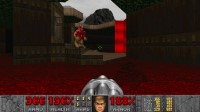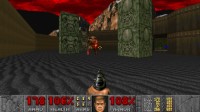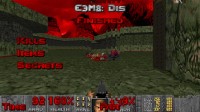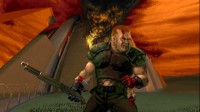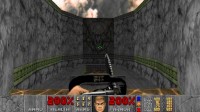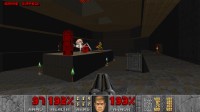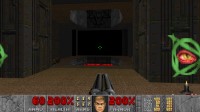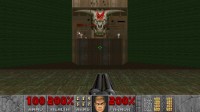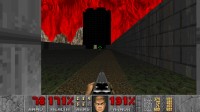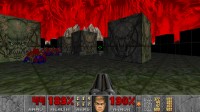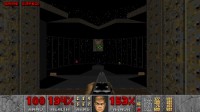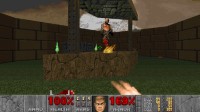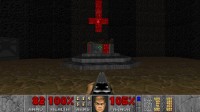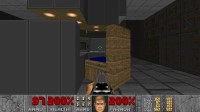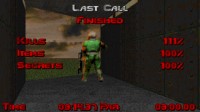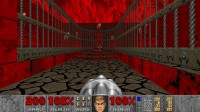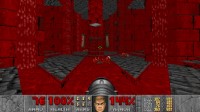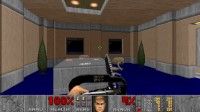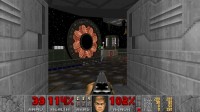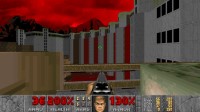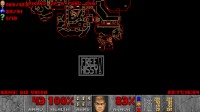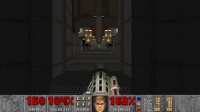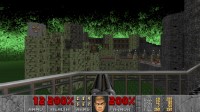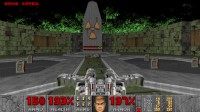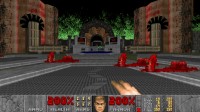DOOM 1+2
Total Playtime: 59.3 Hours
DOOM 1 Playtime: 8.9 Hours, finished 12 September 2024.
SIGIL Playtime: 3.1 Hours, finished 13 September 2024.
DOOM 2 Playtime: 9 Hours, finished 12 December 2024.
DOOM 2 Master Levels Playtime: 8.1 Hours, finished 15 December 2024.
TNT Evilution Playtime: 11 Hours, finished 07 February 2025.
Plutonia Playtime: 9.2 Hours, finished 14 February 2025.
No Rest for the Living Playtime: 2.6 Hours, finished 07 April 2025.
Legacy of Rust Playtime: 7.2 Hours, finished 10 April 2025.
Achievement Completion: 0.2 Hours, finished 10 April 2025.
I'm playing through all of the games & expansions included in the remastered 2024 KEX engine release: DOOM 1, SIGIL, DOOM 2, DOOM 2 Master Levels, DOOM 2 TNT, DOOM 2 Plutonia, No Rest for the Living, and Legacy of Rust. Playing in the order listed above, critically with SIGIL before DOOM 2 because it's meant to be a spiritual "Episode 5" to the original DOOM and does not include the SSG or new enemies introduced in D2.
I played through all of these "vanilla" on the KEX engine with no further modifications or improvements (such as mouselook). I'm setting the difficulty to Ultra-Violence throughout all of the chapters since I really want the levels to feel as complete as possible (from what I understand most levels are designed for UV first, then enemies removed for lower difficulties). To counteract the higher difficulty of many of these episodes that are far beyond what a casual DOOM player can handle, I'll be adjusting my savescumming accordingly since I don't care to spend the hundreds of hours required to thoroughly repeat and learn these levels inside and out. For the same reason, I have no interest in doing the runs with pistol start for every level. It's not a pure run, sorry!
DOOM 1
From what I remember, the last time I played the original DOOM games was over a decade ago, and that playthrough was done with Brutal DOOM on a different source port, obviously contributing to a very different, more modern feel. So for all intents and purposes, I don't think I've ever actually played the games more or less as they were originally (specifically with the original weapon handling and lack of vertical mouselook). After playing through part of this collection, I feel like I understand pretty well why that's the case - the game honestly hasn't aged particularly well for several reasons with the shortcomings in handling vertical distances being one of the key contributing factors. While I understand that there is still a very large community that appreciates the original game (with very limited improvements) for what it is, from my perspective I can only say that it's very clear to me that much of the hype and reputation built around the games themselves is just empty words from people who have heard about or dabbled lightly in the games, but never tried to reach too deeply in themselves.
Mechanically, the game features very fast, but very floaty movement. I've kind of gotten somewhat used to it over the course of the episodes, but this game has even more of a "lead brick on a ski" feeling than plenty of 3rd person action games today. Lots of levels, particularly in the expansions like to turn this into a bit of a challenge, featuring very thin raised pathways that are very tough to navigate without accidentally dropping down, bonus points if enemies are actively firing at you while you're tightrope-walking across it. Also, since there's no jump in this game, elevation differences and platform gaps are a critical element of level design, allowing for many secrets to be hidden in plain sight but stuck behind a knee-high box or something that renders it inaccessible initially. This actually ends up working quite well in these games, as these limitations allowed developers and level designers to realize the importance of showing a goal before you can reach it as a way to elucidate or motivate the player to find the way to access it. More complex level designs forcing detours are possible without feeling particularly contrived, unlike many games today that don't have the ability to exercise the same concept without causing players to simply beeline from location to location, or without jamming unbreakable glass & invisible walls everywhere.
The weapons are pretty good in this game, and I particularly like the accuracy of this shotgun which is quite competent at sniping enemies across rooms. The pistol is truly quite useless though, and most weapons have quirks that make them less than stellar when comparing against other games. The chaingun sounds quite weak and ultimately has a pretty lame damage output, and the projectile-based weapons have a serious problem clipping on walls and corners which can make them frustrating to use. Also, the rocket launcher has an awkward delay before firing that really throws the feel of it off and makes it quite annoying to use. Ultimately though, I think the biggest problem isn't necessarily the weapons, but the unreasonable tankiness of the enemies that actually tends to make encounters more boring than anything. There's such a big gap in endurance between the light enemies like enemy humans and imps, against heavier enemies like barons or cacodemons; with relatively low ammunition caps, wasting 15-20 shotgun shots on a baron or around 6-7 on a cacodemon not only feels like a waste of time just holding M1 for 10+ seconds, but makes the ammo scarcity on harder maps feel cheap than anything. DOOM 2 ends up addressing this somewhat from what I remember, adding a few more intermediate-strength enemies to bridge the gap. That said, the massive randomness in damage output (from both players and enemies) is another huge contributing factor that makes the game feel very inconsistent and another big reason why I think the gunplay is ultimately just mediocre.
To go back to a point that I touched on much earlier, DOOM's biggest issue by far is the engine's poor handling of verticality. Many levels can be more or less designed with it in mind, but the way that elevation differences are actually handled in gameplay really holds it back. A very big, fundamental problem I have with the games is the over-reliance on vertical auto-aim, and auto-aim in general. A pretty significant element of the community has managed to delude themselves that this is a good thing, but even the developers have historically said that full mouselook would have enhanced the game. I agree; even in some of the D1 levels, you're already shooting at enemies that are entirely off the screen above you, or below you and obscured by the giant weapon viewmodel in your face. Naturally, since you can hit them, they can also shoot at you which means in certain levels you'll be taking damage seemingly from nowhere. To say that this is a conscious design choice, or to claim that DOOM (or shooters in general) never needed to progress beyond the horizontal axis is clown behavior. As another part of this limitation, trying to jump off a high ledge is impossible if something 20 feet below happens to take up the same horizontal space, and they can even bite you if you're standing at the edge of a cliff or ledge.
My impression of DOOM based on my experiences with the DOOM 64 port were that it would probably feel like an even more antiquated game that is amusing to play, but ultimately not particularly special. After playing this, I think that impression was quite accurate; this game is very poor compared to its contemporaries, almost all of which are superior. The Build engine games feature a more complete 3D feel with jumping and aiming, even if it has a bit of a janky feeling sometimes. Meanwhile, System Shock completely stomps DOOM when it comes to its ability to convey a proper atmosphere, deeper and more varied mechanics, a narrative and environments that are worth learning about, and a feeling of continuity on a single persistent space station instead of these small, instanced, non-sequitur maps (note that Ultima Underworld actually supported more complex first-person features before DOOM, though DOOM presented them better). That said, DOOM is still decent fun; mindlessly shooting up rooms of various undead and hellish creatures is a timeless form of entertainment.
SIGIL
This episode is kind of a distant spiritual sequel to the original DOOM, with level codes named E5MX. It also keeps its content mostly restricted to things available in D1, without introducing new enemies or weapons availble in later releases. I decided to play it immediately after finishing D1 for that reason. While it has some pretty interesting mechanics (like all of the eye doors), it's otherwise a decent but not outstanding chapter. Kind of similar to how Thy Flesh Consumed massively ramped up the difficulty beyond E3 levels without offering the same consideration to the level design quality in my opinion, I feel like SIGIL once again turns the crank a couple more notches but also adds some more bullshit that makes it a bit less enjoyable as an overall experience. I don't think there's anything off the top of my head that is E4M2 levels of garbage, but most of the levels are primarily memorable for being just kind of OK.
One of my biggest peeves that I didn't mention in my comments about D1 is excessive use of darkness to obscure enemies & objects, making it impossible to actually see enemies at all given the primitive shading and lighting technology in this game. It was bad in the original Final DOOM episodes, but it's even worse here. On top of that, several maps in this episode have areas with seizure-inducing flashing between total darkness and brightness which make them a headache to play at all, which seems like pretty awful design to me. Another distinctive element in this chapter is a very frequent use of random cyberdemons placed strategically to force the player to move around quickly. This is pretty cool in concept but also ends up being quite inconsistent due to random splash or direct hit damage that can occasionally instakill you. That makes me think that SIGIL was designed to be save-scummed in a first playthrough (individual level runners or hardcore players can probably learn most of these patterns), which is exactly what I did.
Overall, I thought this was just barely a passable episode if I'm being generous. I think dedicated DOOM players might have a decent amount of fun learning the ins and outs of each map (in particular, I think the Cyberdemons require some pretty interesting movement & pathing), but I have no intention of touching it again.
DOOM 2
The sequel to DOOM doesn't make too many earth-shaking changes in general, but some solid incremental improvements. On the player's side, the addition of the SSG fills a critical niche that was sorely missed in DOOM 1 and SIGIL - that being close-range burst damage. Previously, the chaingun couldn't output much DPS without exposing yourself to enemies and the rocket launcher was too dangerous to use up close, while the base shotgun really didn't have enough damage output to clean up enemies quickly, not even being able to consistently one-shot imps much of the time. With plentiful ammo and incredible damage potential, it's no surprise that DOOM 2's SSG became the poster child of Doomguy's arsenal, especially given the heavier emphasis on large groups of bulkier enemies in the new levels. I personally liked how well balanced the two shotguns seemed - I thought the SSG would make the basic pump SG obsolete, but it ended up still being useful for sniping and killing smaller enemies a lot of the time. An important difference between the two is that the original SG fires a tight spread in a perfectly flat line, allowing it to be used with solid effect at long distances, while the SSG basically peppers its pellets all over the place, making it wildly inaccurate at anything other than barrel-stuffing distance but still very effective for clearing out entire groups of weaklings too.
The other major gameplay difference in DOOM 2 is the addition of several new enemy types - chaingunners, mancubi, revenants, pain elementals, hell knights, arachnotrons, and archviles all make their first appearances in this game. This really fills out the roster of demons, adding a ton variety to the demons' midrange bulk that DOOM 1 didn't really have, and motivating the inclusion of the SSG. For the most part, I really like the mechanics of these new enemies - chaingunners add a serious hitscan threat though they are still reasonably easy to kill, and many of the other midrange enemies (mancubi, revenants, hell knights, arachnotrons) add lots of projectile threats that encourage lots of active dodging and close-range, high-speed combat. This is especially true for the revenants, which have some (absurd) homing rockets. The pain elementals are a huge pain in the ass (no pun intended) that I really wish weren't added, since lost souls are awful enough and the idea of having an infinite spawner for them is just awful. Finally, the arch-viles are a pretty cool concept for a sub-boss; it's not very tanky by itself, but its ability to resurrect any other monster AND having a damaging hitscan "spell" makes it far more dangerous than any other non-boss demon in the series by far. In general, I'm happy with the additions, but I find it interesting that there were no "boss"-level demons added like the Cyberdemon or Spiderdemon, given that the Icon of Sin is more of a special encounter than just a normal enemy.
Though I really like the SSG and most of the new enemy designs, I have to say that the actual maps making up the DOOM 2 campaign don't quite hit that same bar of quality. The level designs themselves are mostly very abstract, with little resemblance to anything and with no real logic behind their construction. While DOOM 1's levels were generally built around some obvious theme (like some kind of UAC base, spaceport, etc.), DOOM 2's levels all just feel like completely random jumbles of corridors and rooms. This may partly be motivated by the fact that DOOM 2 doesn't have any clearly-defined episodes unlike DOOM 1 - but even then, the only change between the three "sections" of the game (base, city, hell) is mostly superficial. I honestly can't think of a single memorable level other than the first map, Entryway - but that's actually mostly because of the Killing Floor custom map that I used to farm probably ~50% of my demolitions perk points. The final map, Icon of Sin, might also count as well, but that's just a boss arena. Since there is no per-episode "reset" of weapons and ammo at any point in this game (note that I'm using continuous play, not pistol start), the intensity of the levels basically reached its logical peak only a few levels in. The difficulty curve as a whole was quite weird, actually; I found that a lot of the mid-game levels were really rough slogs with tons of enemies and pretty miserable encounters, while the hell levels near the end were actually easier & somewhat smaller in scale overall.
Seeing as the enjoyment of any set of DOOM maps lies more in the design of the encounters, and less in the fundamental mechanics which are more or less unchanged between games or IWADs, I can't really say DOOM 2 is particularly great. However, I feel that the overall contributions of DOOM 2 to the series a whole really helped lay a foundation for much of the identity of the series - as this game started a bit of a shift towards having a balanced, diverse roster of heavy, imposing enemies that the series is known for today.
DOOM 2 Master Levels
Oof, these levels were a very mixed bag. That's more or less to be expected since the Master Levels release was essentialy id's attempt to cash in on the expansion pack system, but the average quality of the maps in this set is pretty damned low. These maps were pretty much all meant to be played individually from a pistol start, but I very thankfully didn't do that since there are some really stinky starts in this one (like "Trapped on Titan", with multiple chaingunners attacking you immediately). Also, to be more specific, there are a couple of mini-sets of levels in this expansion that are connected to one another, like the Inferno or Titan levels. I believe the overall map order was adjusted in the latest version of the DOOM 1+2 collection compared to previous Master Levels releases, and the difficulty curve feels a little bit more consistent now, starting with a couple of nice and easy levels and building up towards the more grueling ones.
There are still a few highlights among the levels, but note that the overall conversation on almost all of them is extremely controversial. Personally, despite its ridiculous length, I actually really enjoyed The Black Tower, which had a really cool concept involving fighting through a number of floors towards a cyberdemon encounter at the top, then fighting your way back down the tower to escape. It took me about an hour to finish (it has about 380 demons on UV!) and I had to take a break in the middle of it as it was so exhausting to play, but it did feel quite balanced overall, at least compared to many of the other maps. Many of the other early levels & the Inferno levels were also decent, but not particularly engaging - I'd say they were neither better nor worse than the average DOOM 2 levels.
Unfortunately, there were some serious lowlights as well - particularly TEETH for me. That level is at another level of claustrophobic dogshit, with really bulky enemies spawning in your face with nowhere to dodge or take cover. It really is simply a miserably-designed level, and the elevator gimmick really just showcases how terrible the lack of vertical aiming is in this game. Trapped on Titan has a terrible starting segment, spawning several chaingunners in your face that are pretty much impossible to avoid, and the final level, Mephisto's Maosoleum [sic] is basically just DOOM 2's Icon of Sin fight but worse in every way. Through continuous play and liberal savescumming, even the worst of these didn't block my progress, but I dread the idea of even attempting a pistol start on any of these.
Overall, I think some of these maps were pretty cool concepts in theory, but most of them didn't work out well. For this run, I wanted to just push through them since I'm trying to get the full experience of the collection, but realistically I will probably never play any of them again.
TNT: Evilution
The first major expansion from Final DOOM is kind of a mixed bag. There were a couple of decent maps, but as a whole it didn't really feel too cohesive in style or in difficulty. I'd say the first few levels all feel like decent starting levels, with relatively few enemies and light resistance, but afterwards many of the remaining maps become a huge slog, not really due to difficulty but moreso due to bloated enemy counts. One of the key traits of many levels in this IWAD is the massive number of low-level enemies - with the bulk of each level's enemy force consisting of primarily of shotgunners, chaingunners, and imps with relatively few heavy-hitters. This is true throughout the entire campaign, which results in a very manageable difficulty level quite similar to the Master Levels, and maybe a decent bit beyond vanilla DOOM 2.
I just feel like the tenets of level design followed in this WAD are all over the place, and it doesn't always work out. Most of the levels tend to be quite large, which makes TNT a bit more exploration-heavy with few intense encounters. Enemies tend to come at you a constant, manageable trickle instead of actively overwhelming you - while I don't hate how relaxing this makes the game, it also means that none of the encounters themselves are memorable. Coupled with some extremely large enemy counts (on maps like Admin Center or Mt. Pain), maps frequently take forever to complete and are exhausting to play. At best, it just barely manages to fill a niche of being brainless fun - I can't deny that it can be satisfying to gun down hordes of weak enemies.
Unlike its more notorious companion in Final DOOM, I feel like TNT doesn't really go any further than its sticker objective to provide "more DOOM". It's basically just 30 regular levels with no distinctive level design or encounter design concepts showcased. To be fair, a degree of discord within the level set is expected, as this expansion was produced by TeamTNT, a mapping collective comprised of several level designers, as opposed to Plutonia, which was made by the concentrated efforts of just two people.
The Plutonia Experiment
The second expansion in Final DOOM is generally even worse than TNT, in my opinion. It's generally regarded as a far more difficult WAD, which is pretty much exactly my experience. My problem with it is that the way Plutonia interprets difficulty is to cram levels full of bullshit, basically. There are countless instances where massive groups of chaingunners or revenants will essentially spawn or appear right behind you to delete a ton of your health with no real way to counteract it without prior knowledge, high-level enemies with little to no equipment, and arch-viles on almost all of the maps which just add to the tedium. When just doing a single, linear playthrough of the levels, it's kind of astounding how terrible the vast majority of the levels are; I can't think of a single level which I think is actively good, just varying degrees from iffy to awful. Shoutout to the arch-vile maze for somehow being one of the more interesting and fun levels in the map.
I think the disconnect between the community opinion of Plutonia and my own comes mostly down to differences in the way the game is played. It's clear that most of the maps are designed to be played multiple times; the cheap traps and challenging encounters encourage replays of the level, getting accustomed to enemy positions, spawn triggers, and potential safe spots from which you can more carefully pick high-priority targets off. From this point of view, each map looks like a puzzle to be solved slowly by learning. The fact that each level tends to be smaller in size with far fewer enemies than TNT (most levels have fewer than 100 enemies) and is meant to be completable with a pistol start makes this pretty obvious. Really, as someone just coming in for a single playthrough to see the sights, the large levels and exploration of TNT were a slightly more enjoyable experience overall.
That said, while I was initially wholly negative on Plutonia, I think there are still a number of positives to take from the overall experience. As mentioned, the shorter levels are kind of a relief, though that was mostly because I couldn't stand playing very much every day in my case. I think the fundamental concept is pretty cool as well, and actually works as a decent counterpoint to TNT's adventure-style maps. I also liked that DOOM's massive roster of demons was utilized more in this expansion - instead of fighting through hordes of marines and imps, Plutonia lets you spend more time fighting the big guys - including several Cyberdemons & Spiderdemons throughout the campaign. Finally, while the first ~20 levels or so were generally horrendous (and almost unplayable IMO), the last 10 levels were far more forgiving with weapons and ammo and were much better as a result. They kind of felt like a progenitor to Serious Sam in that fashion, and were pretty close to being decent.
So I'm never touching this piece of crap again - I don't like the "cheap" design philosphy, and moreover I don't think DOOM is fundamentally good enough for me to replay anything to the point where Plutonia becomes meaningful & fun content. I don't regret playing through it though; if nothing else, I think it really helped me understand why the DOOM community heavily prefers challenge maps like these.
No Rest for the Living
This campaign was short & sweet, just about the size of one DOOM 1 episode. I believe it was made as a little bonus campaign for an earlier console rerelease of DOOM 1 & 2, so it's not really built as a massive expansion. Difficulty-wise, it's slightly more difficult than the main D1/2 campaigns, but nowhere near the difficulty of Plutonia or Thy Flesh Consumed. I'd roughly put it even with TNT, though the level designs are vastly different; NRftL doesn't have swathes of basic enemies to gun down in every level, instead focusing on a solid balance of light, medium, and heavy enemies in tough encounters with resource limitations. In general, weapons and ammo are fairly limited - I rarely had full ammo for everything, and there don't seem to be any backpacks throughout the campaign (maybe in secrets I missed) until the boss level. I also never found the BFG if there is one. Overall, though I don't have much to say about this, I think this is overall probably my favorite campaign in this release outside of the classic D1/D2. With few (if any) exceptions, pretty much every level was fun to play.
Legacy of Rust
I left the newest for last - Legacy of Rust is DOOM's analogue of MachineGames' Quake remaster campaigns (Q1: Dimension of the Past/Machine, Q2: Call of the Machine). Unsurprisingly, it feels quite new and very polished compared to most of the other campaigns. The new enemies are interesting and generally fit the game well: the exploding guys are cool, the new lost souls aren't actually that annoying, and even the mini-cyberdemons have their place. However, I'm a bit torn about the Vassagos, as invisible splash DoT isn't a very fun implementation - there's no good indication how wide the spash range of a fireball is, which often leads to nigh-unavoidable damage. Speaking of fire, the plasma gun and BFG were replaced with fire-based counterparts in the flamethrower (which effectively acts as a close-range plasma gun with splash & light DoT) and Calamity Blade. The flamethrower has the same issue as Vassago fireballs, in that the splash range is invisible and can cause unintended self-damage, but the Calamity Blade is really cool. They're both very powerful, and the pacing of ammo pickups in the levels really encourages extensive use of them.
LoR only consists of two episodes, each with 7 levels. However, even though the level count is "small", the size of each level is absurd - the average enemy count for each is around or upwards of 300. Unlike TNT, these generally are not exclusively massive slaughterfests, but instead contain reasonably balanced enemy compositions (just like NRftL). The levels are generally groups of smaller arenas, rather than monolithic stages - so kind of like Serious Sam, each individual encounter feels big but not quite as overwhelming as the counter might imply. The quality of the levels varies wildly - there are some really awful ones (The Coiled City really comes to mind here), and some really fun ones (personally, I really like Soul Silo and several others). A few of the final levels had some serious issues with ArchVile and Vassago spam which kind of hurts replayability IMO. Kind of like NRftL, resource limitations and management is a key element of this campaign - I don't remember finding a backpack at any point.
Overall, LoR isn't perfect but was a very nice change of pace at the end of the DOOM collection; it was really nice to see some new enemies and weapons after probably ~40 hours of the same old DOOM2 roster again and again. I'm pretty glad that I left this for the end. One final note - every piece of music in this campaign is incredible. The title theme, level themes, etc. were great, and the more techno/dance music was similarly refreshing after the MIDI rock/metal of the other campaigns.
Achievement Completion & Overall Thoughts
I originally thought I would have to spend some real time (a few hours) to finish off my achievements after beating the rest of the game, but apparently not so. Firstly, the achievement for killing every enemy type does not require the DOOM 2 Wolfenstein secret enemies, so I didn't have to deal with that at all. Secondly, the UV speedrun achievement ended up being trivial to bypass just by turning on invincibility and noclip, so that ended up being super easy too. I feel like my opinion at the end of the campaigns hasn't really changed much since the beginning - I'm disappointed about the lack of mouselook and I still feel like the game is a bit archaic at this point, but clearly far from unplayable. I don't think I'd ever really care to run through this again but it feels nice to finally finish all of the expansions that I never got around to playing.
